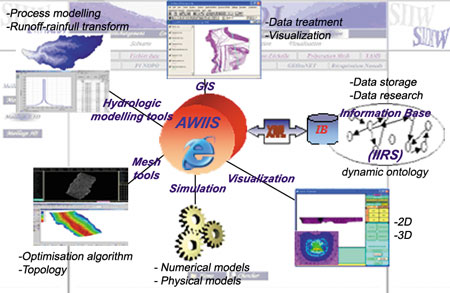
This issue in pdf Subscription Archive: Next issue: July 2005 |
|
||||
AWIIS: An Adaptive Web-Integrated Information System for Water Resources Modelling and Managementby Fadi El DabaghiThe AWIIS is a Spatial Decision Support System for rational planning, operation and management involving water resources. It provides the user with a customized overview or partial view depending on the user profile and the use context. This is achieved through dynamic ontology, using the concept of relevance feedback and a thesaurus based on substitutes of documents. The management of water resources is a highly complex and tedious task that involves multidisciplinary domains including data acquisition and treatment, multi-processes and therefore multi-models, numerical modelling, optimization, data warehousing, and the analysis of exploitation, socio-economic, environmental and legal issues. In addition, given water's vital role in human life, the continuous decrease in its availability due to over-exploitation and pollution, and its scarcity in arid areas, there is a clear need for better design and optimal use of hydro-systems. In this context, a rational analysis must be based on an approach that considers all related causes and effects and systematically evaluates the various alternatives. These include preserving water for irrigation, managing watersheds, building dams to alleviate the impact of floods and improve the water supply, simulating floods for risk prevention, oxygenating lakes to eliminate eutrophication, etc. For this, we have developed a Web-Integrated Information System (WIIS) dedicated to the management and modelling of water resources. This system is an infrastructure of development: perennial, open, modular, robust, effective and convivial, offering a complete, dynamic and configurable environment.
The WIIS architecture consists in two levels: the first contains general modules such as viewers, GIS, grid generators, a data warehouse and simulators, while the other is domain-specific and includes all the relevant modules tackling numerical modelling for the water-related physical application under study, ie hydrology, hydraulics, hydrodynamics and floods. This architecture is based on integration principles linking software components with heterogeneous data sources. Within this objective, we confront an important conflict. On the one hand, there is a considerable need for flexibility in the simulation of water phenomena and the representation and handling of input/output data, which are characterized by the absence of fixed and rigid structures. On the other hand, these data, exchanged within the WIIS, are a priori unstructured, heterogeneous and distributive, which means they are not easily accessible or exploitable. Within this framework, we looked at the definition of a model for the representation and structuring of the data using XML techniques. Accents were put on both the customization of the WIIS and its adaptation according to the user profile and the context of use. In the first stage, we led a pseudo-XMLization of all the data accessed or exchanged within the WIIS through an Information Indexation and Research System (IIRS). This IIRS operates on a thesaurus based on Substitutes of Documents (contains the essential information and description of the original document as well as a link to its real locality) under XML structure of the data warehouse, characterized by strongly heterogeneous and distributed contents. The second stage aimed at setting up an Adaptive Web-Integrated Information System (AWIIS), which is based on the WIIS and is robust and effective in terms of integrated tools and data. This AWIIS must provide a convivial, adaptive interface, rich in information, and possibly with an overview or various partial views according to the situation. This customization is closely dependent on the user profile and the context of use. The AWIIS will also integrate a PIRS (Personalized Information Research System), which generalizes on the IIRS. It should be dynamic and evolutionary, use the concept of relevance feedback, and its driving idea is the combination 'request-result-user'. This PIRS operates on dynamic ontologies built around a thesaurus, which is based on substitutes of documents of our data warehouse. All the components of the WIIS are built through Java intelligent interfaces within an appropriate user-friendly framework under a client/server application. They are portable on both Unix and Win platforms, and provide coherence in the distribution of data treatments and/or between client and server. The client prepares and sends requests to the server, a powerful Unix machine in terms of memory and input/output capacities, which provides direct access to a parallel computing machine or HPCN facilities. This platform allows inter-application navigation, cooperation between software and ease of use on the client and/or server station, cooperation between programs as an environment of development, and access to distant materials and software resources (eg real or virtual parallel machines, data, calling of remote procedures such as execution of heavy numerical codes on the UNIX server, storage etc). Hence, it permits users to carry out an efficient impact assessment analysis for sustainable development, while taking into account socio-economic, legal and environmental issues. This work was supported by the WADI (Water Supply Watershed Planning and Management: An Integrated approach) Euro-Mediterranean Project and French bilateral cooperation programmes (CMIFM - Franco-Moroccan Cooperation: MA/01/03, CMEP - Franco-Algerian Cooperation: 01 MDU 529, and PLATON - Franco-Greek Cooperation : 05572UB). The WADI project was managed by ERCIM through a consortium consisting of INRIA-France, FORTH/IACM-Greece, EMI/ONEP-Morocco, ENP-Algeria, Calabria University-Italy and ESIB/CREEN/EUCLID-Lebanon. Please contact: |
||||


